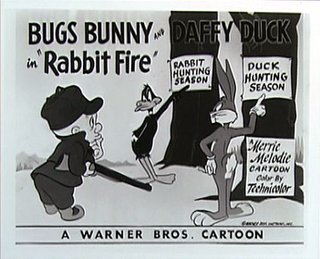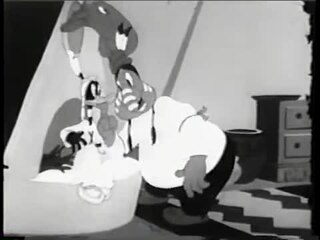Related Research Articles

Looney Tunes is an American animated franchise produced and distributed by Warner Bros. It began as a series of short films that originally ran from 1930 to 1969, concurrently with its partner series Merrie Melodies, during the golden age of American animation. Following a revival in the late 1970s, new shorts were released as recently as 2014. The two series introduced a large cast of characters, including Bugs Bunny, Daffy Duck, and Porky Pig. The term Looney Tunes has since been expanded to also refer to the characters themselves.

Daffy Duck is a fictional character created by animators Tex Avery and Bob Clampett for Leon Schlesinger Productions. Styled as an anthropomorphic black duck, he has appeared in cartoon series such as Looney Tunes and Merrie Melodies, in which he is usually depicted as a foil for either Bugs Bunny, Porky Pig or Speedy Gonzales. He was one of the first of the new "screwball" characters that emerged in the late 1930s to replace traditional everyman characters who were more popular earlier in the decade, such as Mickey Mouse, Porky Pig, and Popeye.

Porky Pig is an animated character in the Warner Bros. Looney Tunes and Merrie Melodies series of cartoons. He was the first character created by the studio to draw audiences based on his star power, and the animators created many critically acclaimed shorts featuring the character. Even after he was supplanted by later characters, Porky continued to be popular with moviegoers and, more importantly, the Warners directors, who recast him in numerous everyman and sidekick roles.

Speedy Gonzales is an animated cartoon character in the Warner Bros. Looney Tunes and Merrie Melodies series of cartoons. He is portrayed as "The Fastest Mouse in all Mexico" with his major traits being the ability to run extremely fast, being quick-witted and heroic while speaking with an exaggerated Mexican accent. He usually wears a yellow sombrero, white shirt and trousers, and a red kerchief, similar to that of some traditional Mexican attires. To date, there have been 46 theatrical shorts made either starring or featuring the character.

Sylvester J. Pussycat Sr. is a fictional character, an anthropomorphic cat in the Looney Tunes and Merrie Melodies series of cartoons. Most of his appearances have him often chasing Tweety Bird, Speedy Gonzales, or Hippety Hopper. He appeared in 103 cartoons in the golden age of American animation, lagging only behind superstars Bugs Bunny, Porky Pig, and Daffy Duck. Three of his cartoons won Academy Awards, the most for any starring a Looney Tunes character: they are Tweetie Pie, Speedy Gonzales, and Birds Anonymous.

Merrie Melodies is an American animated comedy short film series distributed by Warner Bros. Pictures. It is the companion series to Looney Tunes, and featured many of the same characters as the former series. It originally ran from August 2, 1931, to September 20, 1969, during the golden age of American animation, though it had been revived in 1979, with new shorts sporadically released until June 13, 1997. Originally, Merrie Melodies placed emphasis on one-shot color films in comparison to the black and white Looney Tunes films. After Bugs Bunny became the breakout character of Merrie Melodies and Looney Tunes transitioned to color production in the early 1940s, the two series gradually lost their distinctions and shorts were assigned to each series randomly.
Looney Tunes: Back in Action is a 2003 American live-action/animated comedy film produced by Warner Bros. Feature Animation and distributed by Warner Bros. Pictures. It is the second theatrical feature film in the Looney Tunes franchise, and was directed by Joe Dante from a screenplay by Larry Doyle. Brendan Fraser, Jenna Elfman, and Steve Martin star in the film; Timothy Dalton, Heather Locklear, and Bill Goldberg appear in supporting roles, while Joe Alaskey leads the voice cast. Its plot, which parodies action and spy film conventions, follows Bugs Bunny and Daffy Duck as they become intertwined in a plot by the ACME Chairman (Martin) to transform the world's population into subservient monkeys using the Blue Monkey diamond. They accompany aspiring stuntman DJ Drake (Fraser) and Warner Bros. executive Kate Houghton (Elfman) on their journey to thwart the Chairman's plot, which doubles as a mission to rescue the former's abducted father, Damian (Dalton).

The Bugs Bunny Show is a long-running American animated anthology television series hosted by Bugs Bunny that was mainly composed of theatrical Looney Tunes and Merrie Melodies cartoons released by Warner Bros. between 1948 and 1969. The show originally debuted as a primetime half-hour program on ABC in 1960, featuring three theatrical Looney Tunes cartoons with new linking sequences produced by the Warner Bros. Cartoons staff.

Rabbit Fire is a 1951 Looney Tunes cartoon starring Bugs Bunny, Daffy Duck, and Elmer Fudd. Directed by Chuck Jones and written by Michael Maltese, the cartoon is the first in Jones' "hunting trilogy"—the other two cartoons following it being Rabbit Seasoning and Duck! Rabbit, Duck! It is also the first cartoon to feature a feud between Bugs and Daffy. Produced by Edward Selzer for Warner Bros. Cartoons, Inc., the short was released to theaters on May 19, 1951 by Warner Bros. Pictures and is often considered among Jones' best and most important films.

Daffy Duck's Quackbusters is a 1988 animated compilation film featuring classic Warner Bros. Cartoons shorts and animated bridging sequences, starring Daffy Duck. The film was released to theaters by Warner Bros. on September 24, 1988. It was the final theatrical production in which Mel Blanc provided the voices of the various Looney Tunes characters before his death in July 1989.

The Looney Looney Looney Bugs Bunny Movie is a 1981 American animated comedy package film with a compilation of classic Looney Tunes/Merrie Melodies Warner Bros. cartoon shorts and animated bridging sequences produced and directed by Friz Freleng, hosted by Bugs Bunny. The new footage was produced by Warner Bros. Animation. It was the first Looney Tunes/Merrie Melodies film with a compilation of classic cartoon comedy shorts produced by Warner Bros. Animation.

Roman Legion-Hare is a 1955 Warner Bros. Looney Tunes animated short directed by Friz Freleng. The short was released on November 12, 1955, and stars Bugs Bunny and Yosemite Sam. The title is a play on the words Roman Legionnaire. After being ordered by Emperor Nero to find a victim to be tossed to the lions, Yosemite Sam tries to capture Bugs Bunny.

The Daffy Duckaroo is a Warner Bros. Looney Tunes cartoon directed by Norman McCabe. The cartoon was released on October 24, 1942, and stars Daffy Duck. The film is set in the American West, and Daffy plays a singing cowboy.
It's Nice to Have a Mouse Around the House is a 1965 Warner Bros. Looney Tunes cartoon animated short directed by Friz Freleng. The short was released on January 16, 1965, and stars Daffy Duck, Speedy Gonzales, Sylvester and Granny. The voices were performed by Mel Blanc and Ge Ge Pearson.
Quacker Tracker is a 1967 Warner Bros. Looney Tunes cartoon directed by Rudy Larriva. The short was released on April 29, 1967, and stars Daffy Duck and Speedy Gonzales. It was the first of three "buffer cartoons" produced by Format Productions in between Warner Bros. ending its contract with previous Looney Tunes producers DePatie–Freleng Enterprises and re-establishing its own cartoon studio.
Daffy's Diner is a 1967 Warner Bros. Merrie Melodies cartoon directed by Robert McKimson. The short was released on January 21, 1967, and stars Daffy Duck and Speedy Gonzales. It was the final Warner Bros. cartoon to be produced by DePatie–Freleng Enterprises.

Daffy's Rhapsody is a 2012 animated Looney Tunes short film featuring the characters Daffy Duck and Elmer Fudd. Directed by Matthew O'Callaghan and written by Tom Sheppard, the film is an adaptation of the song of the same name which was sung by Mel Blanc and recorded in the 1950s by Capitol Records. It also marked the return of Daffy Duck into his original screwball personality after decades of being miscast as a greedy, self-centered character in most of his post-1940s appearances since the Bugs Bunny short Rabbit Fire (1951). Daffy's Rhapsody was first shown in theaters before Warner Bros.' feature-length film Journey 2: The Mysterious Island. Unlike the previous Looney Tunes 3-D shorts, Daffy's Rhapsody has not yet been released on home media. In 2016, the official Warner Bros. Animation uploaded the short to Google but eventually removed it, leaving unofficial uploads of the short being available. It took until 2021 for the short to be officially available to purchase on Stars of Space Jam: Looney Tunes Collection.

Looney Tunes: Rabbits Run is a 2015 American animated direct-to-video adventure comedy film in the Looney Tunes franchise produced by Warner Bros. Animation. It is the first new Looney Tunes direct-to-video film since Bah, Humduck! A Looney Tunes Christmas was released nine years prior. The film was made shortly after The Looney Tunes Show, and shares much of the same crew as that series, including director Jeff Siergey, who had also been a supervising animator on Space Jam and lead animator on Looney Tunes: Back in Action. It was released on August 4, 2015, by Warner Home Video, but it was released early on July 7, 2015 on Vudu and Walmart.
References
- ↑ Beck, Jerry; Friedwald, Will (1989). Looney Tunes and Merrie Melodies: A Complete Illustrated Guide to the Warner Bros. Cartoons. Henry Holt and Co. p. 365. ISBN 0-8050-0894-2.
- ↑ Lenburg, Jeff (1999). The Encyclopedia of Animated Cartoons. Checkmark Books. pp. 60–62. ISBN 0-8160-3831-7 . Retrieved 6 June 2020.